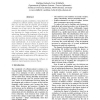Free Online Productivity Tools
i2Speak
i2Symbol
i2OCR
iTex2Img
iWeb2Print
iWeb2Shot
i2Type
iPdf2Split
iPdf2Merge
i2Bopomofo
i2Arabic
i2Style
i2Image
i2PDF
iLatex2Rtf
Sci2ools
110
click to vote
ECBS
2007
IEEE
2007
IEEE
Introducing Impact Analysis for Architectural Decisions
Architectural quality constitutes a critical factor for contemporary software systems, especially because of their size and the needs for frequent, quick changes. For success-critical business systems, architectural decisions are of high risk for the market share and even for the existence of enterprises. These decisions are important for design processes as well as for refactoring. Because of the complexity of the decisions, e.g., uncertain, contradicting goals, unknown effects and risky conditions, decision-making is a difficult and risky task. Risks can be minimized if the decisions are made systematically. In an earlier paper, we introduced methods of Decision Theory to perform such decisions in a rational way. This paper introduces a method for evaluating alternatives of architectural decisions, for both architectural design and refactoring. This method adopts elements of the scenariobased evaluation method ALMA [1]. A practical example illustrates the application of the improved...
Architectural Decisions | Contemporary Software Systems | ECBS 2007 | Hardware | Success-critical Business Systems |
Related Content
| Added | 02 Jun 2010 |
| Updated | 02 Jun 2010 |
| Type | Conference |
| Year | 2007 |
| Where | ECBS |
| Authors | Matthias Riebisch, Sven Wohlfarth |
Comments (0)

